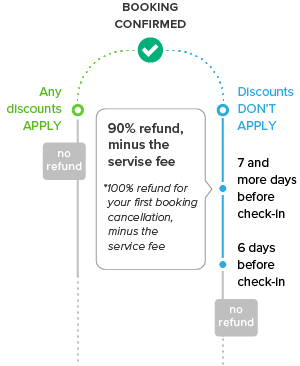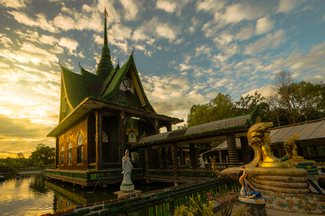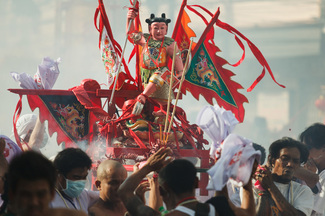Songkran – a Festival of Watery delights
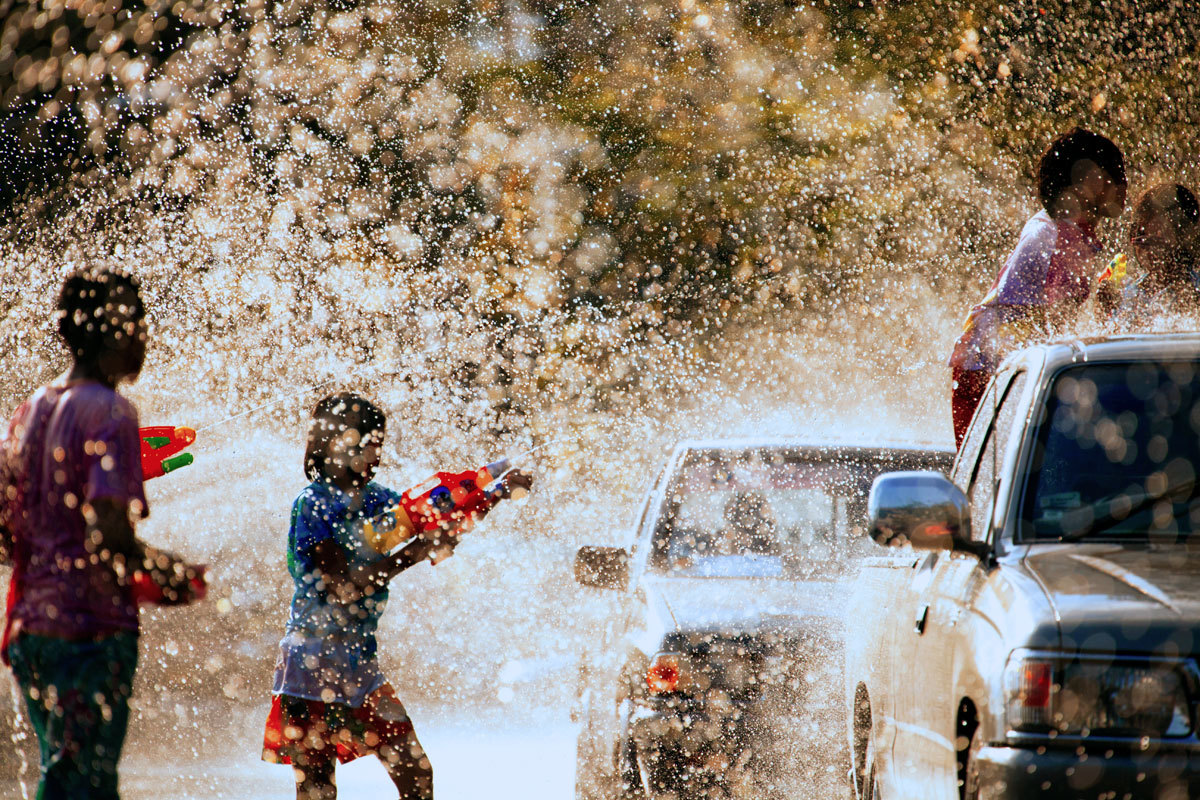
Songkran is Thailand’s most famous and important festival and is celebrated nationwide from 13th to 15th April, the hottest month in Thailand. In some parts of Thailand, particularly in Chiang Mai, celebrations can last as long as a week. In the neighbouring countries of Cambodia, Burma and Laos, local versions of this festival are observed. In times past Brahmin priests would determine the dates according to their astrological calculations, but are now firmly fixed in the nation’s calendar.
Songkran marks the end of the dry season and the beginning of the annual rains and if you are out and about during this festival be prepared to get wet! The word Songkran derives from a Sanskrit word (saṃkrānti) which refers to an astrological change or passing, and marks the start of the Thai New Year. This festival, rich in symbolism and practised with typical Thai enthusiasm and exuberance, revolves around water and its purifying effects.
Thais typically begin the first day by making merit, visiting temples to perform water pouring rituals on statues of the Buddha, offering food to the monks and performing various acts to wash away one’s sins. Songkran is also a time of unity and family and Thais who have moved away from home return to celebrate with their parents and grandparents. Bangkok can be strangely quiet during this time and its infamous traffic congestion considerably eased as about half the population of Bangkok makes this annual exodus. The first day of the holiday is known as National Elderly Day when Thais typically pay respect to their elders and take part in the Rod Nam Dum Hua ritual, which involves pouring fragrant water over the palms of older members of the community and asking them for their blessings.
In many regions there are processions of Buddha images, people clean their houses and dress up in their finest clothes, set off fireworks to ward off bad luck and release birds and fish or other animals as an act of merit making. In parts of northern Thailand there is a tradition of bringing small bags of sand to the local temple to return the dust carried away by bare feet throughout the year. The sand is then sculpted into small stupas in honour of the Buddha.
But, the real fun begins with the water fights, where everyone (except monks) is fair game for a good-natured soaking - joie de vivre Thai style. Be warned though, as a tourist, you are a prime target! All around the country people celebrate by throwing water, by any means, at each other. Be prepared to take it on the chin and give as good as you get. Lock and load and plunge right into the melee on the streets to do battle – no quarter given, none expected!
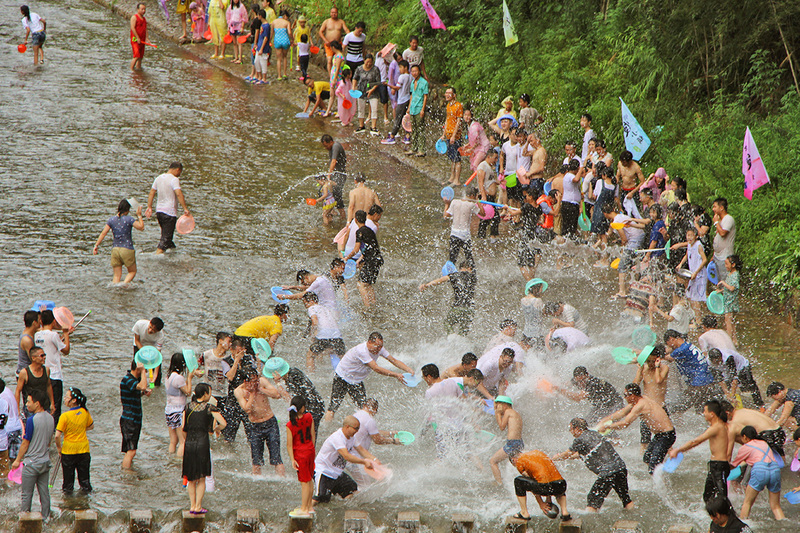
White talcum powder is often also thrown with abandon and some streets after a water fight look as though a blizzard has struck the city. But water is most definitely the weapon of choice in this three-day war of utterly mad, celebratory mayhem. Children and young Thais, armed with giant water guns, or in the back of pick-up trucks amply provided with buckets of water, roam the streets soaking anyone they come across, and in most instances getting equally soaked, and in the searing daytime temperatures most people welcome it, though you might see on the faces of long-suffering tuk-tuk drivers an expression of stoicism rather than joy as they ferry tourists about and endure repeated drenchings.
In Bangkok, the backpackers’ and budget travellers’ enclave of Khao San Road is one of the best places to enjoy the madness and for the locals the best place to find Farang tourists, the favoured prey. Huge and wildly exuberant battles are fought but be warned it can get rather rowdy and a good deal of alcohol is likely to have been consumed and the local authorities can and will take action against what they consider inappropriate or immoral behaviour.
Other more sober celebrations take place in Benchasiri Park and along Sukhumwit Road, where stalls offering Thai food and stages showcasing Traditional Thai music and other activities of a cultural nature allow tourists to experience the more spiritual aspects of the festival.
The Banglamphu district is where you can find cultural performances when Thais wearing traditional outfits perform merit-making ceremonies and put on cultural performances of various kinds at Suan Santi Chaiprakaan Park. Silom Road, the city’s business district also stages a number of activities during the festival. For a more family-friendly setting you might consider heading down to the Central World Shopping Complex where good-natured water fights take place in an alcohol-free environment. There are also traditional beauty contests held at Wisutkasat, where gorgeously attired Thai beauties compete for the crown in the Miss Songkran beauty contest.
At Sanam Luang, opposite the splendid Grand Palace, on the first day of Songkran you can see the greatly revered Phra Phutta Sihing image of the Buddha which is paraded along the streets in order that devotees may sprinkle water over it. The image then remains there for three days so that anyone not able to do so during the parade may still make merit by pouring water over it. There are also carnival floats and cultural shows throughout the period.
It is said that the best place to experience Songkran is Chiang Mai, especially for tourists and travellers. The city’s relatively small size and the large number of wonderful temples and historical buildings offer a stunning backdrop to the festivals many activities. The old city is surrounded by a moat, the water from which, although of decidedly dubious quality, provides a handy source for replenishing water buckets and water pistols.
The festival’s first two days are devoted to family and merit making and one of the highlights is the procession of floats and Buddha images that begins at the Narawat Bridge and makes its way to the splendid Wat Pra Singh, which had the status of royal temple of the first grade bestowed on it in 1935 by King Ananda Mahidol, Rama VIII. As the sun sets on the second day people gather at the banks of the Mae Ping river and collect sand which is taken to the temples, shaped into mounds and adorned with flowers, a ritual known as ‘raising the temple grounds’.
Once the religious and familial obligations have been completed the following days become far more of a party, with spontaneous water fights across the city and in the old town stages are erected from which dancing girls spray the crowds with hoses and bubble machines pump out foam into the streets.
In Ayutthaya, the former capital of Thailand, brightly painted elephants, provided with large containers of water, join in the fun and spray onlookers with obvious relish. There is also a traditional Mon ceremony of bathing the Buddha and offering alms to 999 monks at the Vihara Phra Mongkhon Bophit, after which the tradition of releasing birds and fish from captivity is performed.
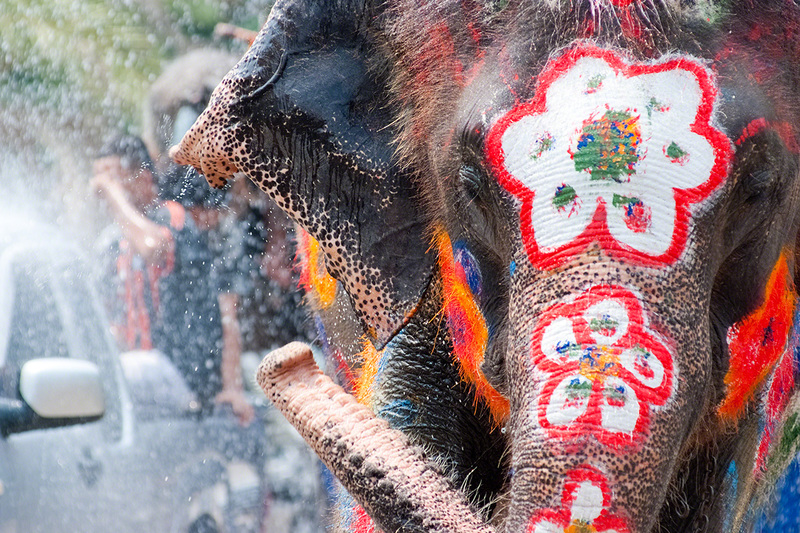
In Pattaya, celebrations culminate on 19th April with the Wan Lai – ‘Flowing day’ - festival, the highlights of which are incredible sand sculptures, Muay Thai fights that take place over the water, a ritual where men carry a woman into the water for a tradtitional dousing and the Miss Songkran Beauty Contest in which both women and ladyboys compete for the title.
Nakhon Si Thammarat in the deep south of the country has one of Thailand’s most revered and oldest temples, the Phra Mahathat Woramaha Wiharn, a beautiful location to watch local people making merit and performing traditional rituals. Uniquely, the town also hosts the Hae Nang Kradan Festival, at the same time it celebrates Songkran, which is held to honour Shiva, who is believed to visit earth at this time every year to offer blessings and protection.
The festival’s origins date back over 1,300 years when a sizeable Hindu Brahmin community lived in the area and begins with a procession that starts from the Ho Phra Isuan temple in the centre of the city where Brahmin priest lead symbolic tablets along candle-lit streets to Sanam Muah Mang, a large park, where devotees gather for solemn reflection and celebration.
One of the most fun places to spend Songkran is Phuket and where better than by the beach. Locals and tourists battle it out in good-natured fun, though some tourists seem to treat the event more like a paint ball fight and lose track of the celebration’s significance as a cleansing ritual. If you venture out into the streets be prepared for a dousing. Some people choose to stay indoors for the duration of the festivities as the action can get a little intense at times, especially along the Bangla Road, where water fights continue well into the night.
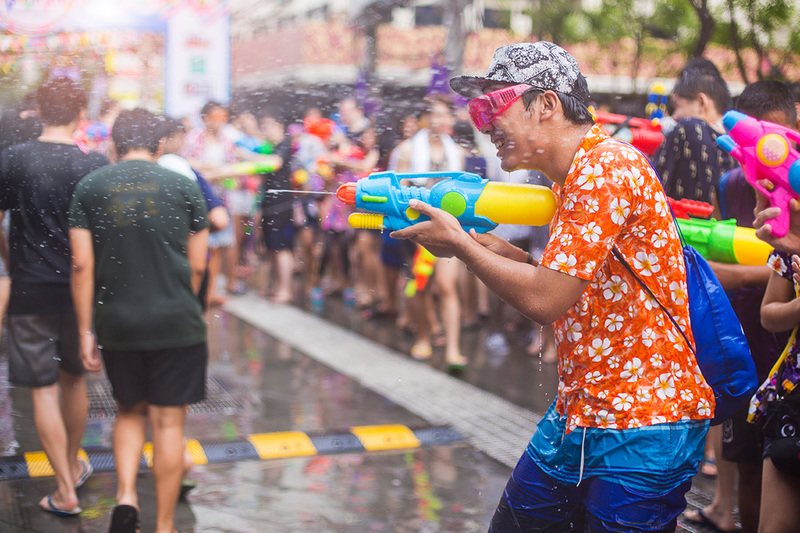
Wherever you celebrate Songkran certain precautions need to be taken. Dress casually but modestly. This is important. Don’t wear anything expensive or likely to be damaged by water and only enough cash for your immediate needs. Don’t ride a motorbike – the traffic jams make this a rather futile exercise in any case. A waterproof camera and phone are a must. Make sure you have plenty of sunscreen as the sun can be very intense even on overcast days, especially at the seaside. Have fun, but don’t go crazy.
Songkran, as celebrated in Thailand, is a uniquely ‘refreshing’ experience, a typically Thai blend of tradition, obligation, cultural affirmation as well as a riotously joyous occasion that gives full vent to the Thai spirit of Sanuk – getting the most fun from whatever you do.










of collaborative energy




Before proceeding to use the website please carefully ready our Terms and Policies
I accept Diwerent's Terms and Conditions and Privacy Policy








